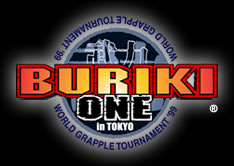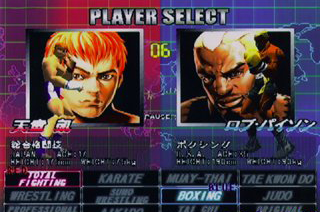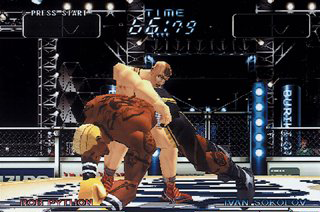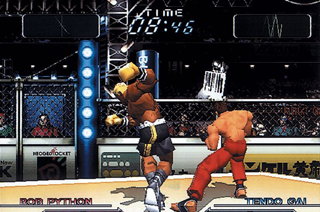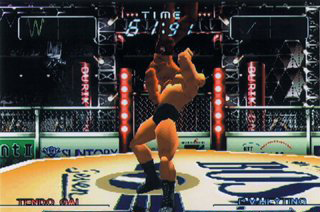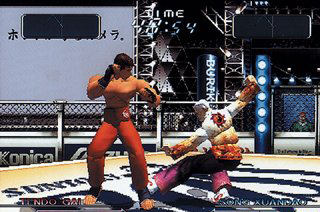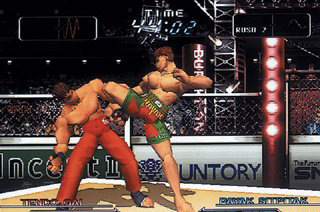Difference between revisions of "Buriki One"
XianXi-12537 (talk | contribs) m (→Move Sets) |
XianXi-12537 (talk | contribs) m |
||
| Line 90: | Line 90: | ||
| − | == '''Gai Tendo''' == | + | == '''Gai Tendo''' == |
| + | |||
| + | (Technique) | ||
| Line 110: | Line 112: | ||
---- | ---- | ||
| − | == '''Rob Python''' == | + | == '''Rob Python''' == |
| + | |||
| + | (Speed) | ||
| Line 130: | Line 134: | ||
---- | ---- | ||
| − | == '''Jacques Ducalis''' == | + | == '''Jacques Ducalis''' == |
| + | |||
| + | (Technique) | ||
| Line 150: | Line 156: | ||
---- | ---- | ||
| − | == '''Seo Yong Song''' == | + | == '''Seo Yong Song''' == |
| + | |||
| + | (Speed) | ||
| Line 170: | Line 178: | ||
---- | ---- | ||
| − | == '''Takato Saionji''' == | + | == '''Takato Saionji''' == |
| + | |||
| + | (Technique) | ||
| Line 190: | Line 200: | ||
---- | ---- | ||
| − | == '''Payak Sitpitak''' == | + | == '''Payak Sitpitak''' == |
| + | |||
| + | (Speed) | ||
| Line 210: | Line 222: | ||
---- | ---- | ||
| − | == '''Song Xuandao''' == | + | == '''Song Xuandao''' == |
| + | |||
| + | (Technique) | ||
| Line 230: | Line 244: | ||
---- | ---- | ||
| − | == '''Patrick Van Heyting''' == | + | == '''Patrick Van Heyting''' == |
| + | |||
| + | (Power) | ||
| Line 250: | Line 266: | ||
---- | ---- | ||
| − | == '''Ivan Sokolov''' == | + | == '''Ivan Sokolov''' == |
| + | |||
| + | (Technique) | ||
| Line 270: | Line 288: | ||
---- | ---- | ||
| − | == '''Akatsuki-Maru''' == | + | == '''Akatsuki-Maru''' == |
| + | |||
| + | (Power) | ||
| Line 290: | Line 310: | ||
---- | ---- | ||
| − | == '''Ryo Sakazaki''' == | + | == '''Ryo Sakazaki''' == |
| + | |||
| + | (Speed) | ||
Revision as of 10:21, 21 July 2008
Buriki One (Buriki One: World Grapple Tournament '99 in Tokyo) is a 3D computer graphics arcade versus fighting game. It is an offshoot of the Art of Fighting series . In the brief time-frame of the Hyper Neo-Geo 64's popularity, it was characterized for its superb graphics that processed at a smooth 60 frames per second and a unique fighting system. So far, it has only been released in one iteration, with no sequels, although the main character Gai Tendo has appeared in later SNK games, via cameos or as a playable character (in the recent The King of Fighters XI). Buriki One is also the last game to be released for the Hyper Neo-Geo 64.
Plot
The setting for BURIKI ONE is Spring 1999 (20 years after Art of Fighting 3). Crowds flock to an arena known as the World Grapple Tournament, where various fighters compete for the championship. The only returning character from the Art of Fighting series is Ryo Sakazaki, as 10 other fighters of different fighting arts enter to be the champion of the tournament. And at the final of tournament, a dark fighter know as Silber appeared.
Story
It's Spring 1999... Fighters from across the world gather at the Tokyo Dome to compete in the World Grapple Tournament. Each contender has their own fighting discipline, ranging from the popular styles of Boxing, Karate and Professional wrestling, to the lesser known arts of Aikido, Tai chi and Muay Thai. Finally, they have the chance to prove which martial art conquers all!
Gameplay
Buriki One is the fourth and final 3D computer graphics fighting game released for the Hyper Neo-Geo 64 system. Buriki One's control system uses two buttons for movement, keeping the player on a 2-D axis, despite the 3D arena. Pressing the left button moves the character in the left direction, pressing the right moves in that respective direction. Double tapping each button produces a dash in each corresponding direction for evasion and closing distance. Pressing both buttons makes the character block.
By using the joystick, the player can execute attacks of varying damage levels. By pressing in the forward direction, the player executes a medium attack, up forward a stronger attack, and down, forward is the weakest, but fastest attack. By combining various combinations of the movement of the stick, a special attack is performed for increased damage. Unlike the 2-D iterations, however, no ranged attacks are present, keeping the preferred fighting distance between players at close quarters.
Screen Shots
The Characters
Total Fighting art
- Gai Tendo: The Main Hero of the Game. He comes from Japan.
Boxing art
- Rob Python: He has a rivalry with Gai Tendo. He comes from the United States.
Judo art
- Jacques Ducalis: He comes from France.
Tae Kwon Do art
- Seo Yong Song: He is a star pupil of Kim Kaphwan and is also good friends with Gai Tendo and Takato Saionji. He comes from South Korea.
Aikido art
- Takato Saionji: He is good friends with Gai Tendo and Seo Yong Song. He comes from Japan.
Muay-Thai art
- Payak Sitpitak: He comes from Thailand.
Tai Chi art
- Song Xuandao: He comes from China.
Wrestling art
- Patrick Van Heyting: (Professional Wrestling) He comes from Holland.
- Ivan Sokolov: (Greco-Roman Wrestling) He comes from Russia.
Sumo art
- Akatsuki-Maru: He comes from Japan.
Boss characters
Sub-Boss
- Ryo Sakazaki a.k.a. The Second Mr. Karate - The only character from Art of Fighting (if chosen by the player in Story-Mode, Gai Tendo will be the Sub-Boss). He is listed as "Karate", though he still uses Kyokugenryu Karate. He comes from Japan.
Main-Boss
- Silber - The game's antagonist, entering the tournament to challenge powerful fighters. He uses various styles, and he will only challenge those who climbed through the finals without a need for a rematch. He comes from Germany, continuing SNK's predilection for German boss characters. His style is listed as "Original Karate", although it is never clearly explained which particular form of "Original Karate" this is.
Move Sets
Legend:
- = Slight Pause
Gai Tendo
(Technique)
Rolling Mace
Slider
Gai Wheel
Tackle (Up Toss)
Keep Position
Gai Spider (Body Attack)
-
Keep Position
Rob Python
(Speed)
Head Collision
or

Twisting Impact
or

Rising Impact
or

Ducking Upper
Atomic Blow (Up Toss)
-

Jacques Ducalis
(Technique)
Palatial Slice (Up Toss)
-
Keep Position
Body Drop (Up Toss)
-
Keep Position
Helicopter Spin (Up Toss)
-
Keep Position
Standing Four-Point Pindown (Up Toss)
(When on his back, from steps)
Fly Swatter (Body Attack)
Seo Yong Song
(Speed)
Tuimyo Bandae Dollyochagi
Flying Heel Drop
Crouch Kick
Rising Back Kick
Bandae Dollyochagi
(After Rising Back Kick)
Takato Saionji
(Technique)
Aikido Smash High/Middle/Low
or
or

Trip-Up Toss (Up Toss)
G +
Forearm Counterblow (Body Attack)
-

Lunging Slam (Body Attack)
-

Body Reverse (Body Attack)
-

Payak Sitpitak
(Speed)
Spinning Elbow Crunch
Theab
Kao - Loy
or

Fist Shatterer (Body Attack)
Kod - Kao - Tee - Kao (Up Toss)
-

Song Xuandao
(Technique)
Pi Li Quan
or

Fei Long Quan
or

Leng Gou Quan
or

Hu Yao Wei
G +or

Xuan Feng Jiao
G +or

Patrick Van Heyting
(Power)
Shark Lariat
or

Shoulder Charge
or

Shark Buster (Up Toss)
-

Jack Hammer (Up Toss)
-
Keep Position
Figure 4 Neck Lock (Up Toss)
(After Jack Hammer)
Ivan Sokolov
(Technique)
Open Palm Thrust
Pull Down (Up Toss)
-
Keep Position
Tackle (Up Toss)
Keep Position
Head Fall (Up Toss)
-

Achilles Hold (Up Toss)
(After Head Fall)
Akatsuki-Maru
(Power)
Super Slap High/Middle/Low
or
or

Freeze Move Back Blow
G +Keep Position
Holy Mackerel Bop (Up Toss)
-
Keep Position
Leg Lock Slam (When Facing Opponent) (Up Toss)
-
or
-
Keep Position
Scoop-Up Toss (When Facing Opponent) (Up Toss)
-
or
-
Keep Position
Ryo Sakazaki
(Speed)
Head Collision
Twisting Impact
(In Front Dash)
Rising Impact
or

Ducking Upper
or

Atomic Blow (Body Attack)
-
Keep Position
